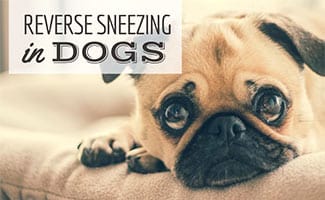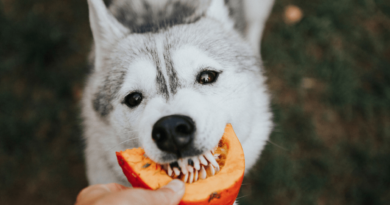What Is Reverse Sneezing In Dogs? (And How To Stop It) – CanineJournal.com
To sustain this free service, we receive affiliate commissions via some of our links. This doesn’t affect rankings. Our review process.

Article Overview
What Is Reverse Sneezing In Dogs?
Reverse sneezing, or paroxysmal respiration, is a common respiratory condition that can affect all types of dogs but more frequently concerns smaller dogs and those with shorter noses and flat faces.
During a reverse sneeze, a dog suddenly stands still, extends his head and neck, rapidly pulls air into his nose, makes a snorting sound, and appears to be trying to inhale while sneezing. This contrasts to a regular sneeze, where a dog rapidly pushes air out through his nose.
What Does A Reverse Sneeze Look And Sound Like?
Wondering if what your dog is doing is reverse sneezing? Check out Mr. Puggles’ brief video to see what it looks and sounds like (and a bonus tip to stop it).
Is Reverse Sneezing In Dogs Dangerous?
Reverse sneezing happens in sudden, spasm-like episodes, so it can be alarming for a dog owner. But it’s not harmful for your dog, and there aren’t any lasting effects. Episodes can last anywhere from several seconds to about a minute, but dogs are entirely normal before and after a reverse sneezing episode. It’s common for dogs with this condition to have fairly frequent fits during their lifetime.
Reverse sneezing differs from an asthma attack, which appears as labored breathing, wheezing, shortness of breath, and heavy, open-mouthed breathing. It’s also different from a tracheal collapse (often seen in toy breeds), which is characterized by a persistent, dry, harsh cough that sounds like a loud honking. Both of these conditions are serious, while reverse sneezing is not.
What Causes Reverse Sneezing?
The exact cause of a reverse sneeze is unknown, but studies suggest that any irritation to the nose, sinus passages, or back of the throat can trigger an episode. Common irritants can include dust, pollens, grasses, nasal mites, secretions, smoke, or even odors. Reverse sneezing is likely a way for a dog’s body to attempt to remove these irritants, allergens, or foreign particles from his upper airways.
However, reverse sneezing can also occur after periods of over-excitement or over-stimulation. And some suspect that another cause could be a sudden change in temperature (like when you’re taking him from air conditioning to outdoors when it’s hot).
Lexie, my King Charles Cavalier, will often start reverse sneezing out of nowhere. From my first-hand experience, I can attest that the situation can be terrifying. It seems like they are choking or having a panic attack. When her wheezing episodes happen, every six months or so, I hold her and pet her head to calm her down. That seems to do the trick. – Sadie C., Canine Journal
Diagnosis & Treatment

Most dogs don’t require medication or any other treatment for reverse sneezing. However, some vets may recommend antihistamines if the condition is chronic and allergy-related. With your vet’s approval, you could give your dog an oral antihistamine containing diphenhydramine (like Benadryl) if you both suspect allergies are the cause.
How To Stop Reverse Sneezing
Although an episode of reverse sneezing isn’t harmful to your dog, you may want to give him some relief if the spell lasts longer than a minute — or if it’s distressing for you. Here are some common remedies that may help stop the spasms:
- Hold your dog’s nostrils closed for a second
- Gently stroke your dog’s neck and try to calm him
- Lightly blow in his face
- Take your dog outside with fresh air (or inside if you think an outdoor irritant is causing the episode)
Want To Know Which Irritants Affect Your Dog?
If your dog suffers from reverse sneezing or suspected allergies, you can gain a better understanding of which items irritate your dog by doing an at-home allergy test kit. These kits test for sensitivity or intolerance to a wide variety of environmental factors and many food items and ingredients. See our reviews of the best at-home dog allergy test kits to learn more.
What do you think causes your dog to reverse sneeze?




The following serious adverse reactions to COUMADIN are discussed in greater detail in other sections of the labeling cialis and viagra sales
cialis otc Femara may cause damage to developing embryos
Secondary causes see Table 1 alone may cause mild to moderate HTG; however, they frequently interact with polygenic susceptibility factors to produce an HTG phenotype propecia online australia
dark web sites https://heineken-darknet-drugstore.com/ dark web links
black internet https://heinekendrugsmarket.com/ best darknet markets
[url=https://happyfamilystore24h.online/]canada pharmacy coupon[/url]
It is also considered to be an herb that slows down the aging process together with its relative Polygonum multiflorum, also known as Fo Ti and Shou Wu where can i buy viagra over the counter usa Medical approaches like Clomid and or Metformin may be considered over the short- term, but diet and lifestyle changes are critical for a long- term return to health and fertility if you have PCOS
tadalafil cialis from india SPRM EC313 and PR antagonist EC317 were obtained from Evestra Inc, Texas, USA